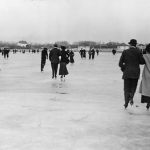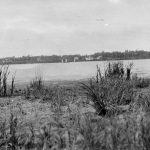Although the lake is no longer visible, its “ghost” is discernable on early maps and in the form of flooding in wet years to the residents whose homes were built on top of the old lake bed. Once, McKernan’s Lake and Lendrum Lake each spanned about thirty acres, connected by a waterway wide enough for a canoe. Located underneath ten city blocks between 110 and 114 Streets and south of 76 Avenue to 72 Avenue, McKernan’s Lake was part of the parcel of land south of University Avenue bought by Robert and Sara McKernan, who came from Ontario in a covered wagon by way of Hay Lakes in 1878.
At that time, the Papaschase Cree were already at the lake, having been pushed south from Edmonton settlement, which then totalled 148 persons, after signing Treaty 6 the year before at Fort Edmonton. McKernan’s Lake, “a haven of nesting ducks” (MacGregor 226), supplied the fort with fish and waterfowl. The southern, eastern and western shores of McKernan’s Lake were “rarely without some Indian teepees” (MacGregor 100) and the sound of drums was a part of early Edmonton life. The presence of drums meant peace, but by 1885 the Papaschase band moved southward again, to what is now 51 Avenue and, by 1888, to Enoch: “It may have been McKernan’s bid to claim land south of Ashen’s and Garneau’s riverlots that forced the issue of locating a reserve for the Papaschase band” (Lawrence 85).
Robert and Sara McKernan lived in a sod house before building a two-story log farmhouse, located where McKernan School is today. There, they raised a family of ten children. Robert also owned land in what is now Belgravia, and opened businesses, including the Dominion Hotel in 1903 and, with his son John, the Princess Theatre in 1914. He presided over the Strathcona Agriculture Society and, as master of the Lodge, organized Orangemen Glorious Twelfth parades and parties at McKernan’s Lake as early as 1895. The Orange Hall, built in 1903, still stands in old Strathcona, along with the Princess Theatre.
When Streetcar No. 1 began running a single-track line on 76 Avenue from 104 Street to Saskatchewan Drive and back starting in November 1913, the population of the city was 63,243. The Toonerville Trolley, nicknamed after Toonerville Folks cartoons, gave Edmonton’s citizens easy access to a lake for all-season recreation. In winter, there was skating, cross-country skiing, hockey, curling and even a giant toboggan slide along with lights, tents, shacks, cookouts and occasional fireworks. The Strathcona Town Band played for a moonlit night skating parties on the lake as early as 1911. In summer, people used the lake for boating, picnics and hiking. But the streetcar rails were built without gravel ballast, so the trolley “often went off track, sank into the ooze of McKernan Lake” (MacGregor 191), on its rock and roll trip on the “sketchy forest-wrapped trail” (MacGregor 282).
On each trip, the motorman had to unhook the trolley, reattach the overhead wire, move the controls to the other end of the car and switch the seat backs so passengers faced the direction they were travelling. The western end of the line was forested ravine, so at night, to know when to stop, the motorman relied on the porch light or lantern of one of the handful of residents, including Dr. W.H. Alexander. When the light was forgotten, the streetcar sometimes crashed into the bush. Dr. W.H. Alexander and Dr. E.K. Broadus were among the university professors with homes at the end of the line: “among the bush and the prairie chicken and the partridges . . . we live, we and our half-a-dozen neighbours” (Broadus 38). Despite the trolley’s five-to-ten-thousand-dollar loss per year, the group saved the streetcar in a 1931 plebiscite. They bought tickets in high volume and distributed them for free, wrote letters to newspapers and successfully gained the majority of votes from the south side of Edmonton to keep Streetcar No. 1. The Toonerville Trolley ran until August 1947.
The next year, McKernan’s Lake was completely drained to make way for 150 new homes. The water was diverted from the lake bed through a series of irrigation ditches to the University Farm. Today, a drop in elevation at 112 Street south of 76 Avenue is a reminder of the edge of the lakeshore. Evergreen Pond, a catchment basin and public park at the 63 Avenue entrance to University Farm, provides an inner-city lake experience that recalls the much larger McKernan’s Lake.
Despite filling in the lakebed, only a few metres deep, with building materials, the “ghost of McKernan’s Lake” emerged in a 1953 flood. Previously, in 1914 after heavy rains, the water rose twelve feet around the lake and flooded nearby houses, so the lake was partially drained but “left for people to skate next winter” by mayoral decree (Monto 345). To keep the water level of the lake stabilized, in the 1920s, a small wooden pump house was erected on 75 Avenue to pump water into the sewer system. Recent storm events in 2004 and 2012 also caused flooding in the area.
Other vestiges of the lake and the trolley that brought people to it manifest in the community spirit of the area today. Just as a group got together to save the trolley, groups in McKernan, Parkallen and Belgravia are vocal about changes and make their needs known to city planners. The communities are known for rallying together to preserve and ameliorate their neighbourhoods. McKernan community league, one of Edmonton’s first, was established in 1932. In the words of University Avenue resident and drama pioneer Elsie Park Gowan, in 1933 McKernan was “on the EDGE of town. There was no 114 Street south of us, but the University farm, with a field of wheat and a handsome barn” (McKernan Messenger, 1981). Perhaps this early isolation encouraged the neighbourliness of the community. The trolley driver was known to wait for returning passengers on the last 10:30 pm car, or cart mail or groceries and packages to residents down the line and even brake for cottontails dazed by his headlight. Before vehicular traffic, the trolley was the spine of the community and the lake was where people gathered.
Kathryn Martell, co-author of Lost Creeks and Wetlands of Edmonton, describes the lasting effect of the district’s past: “Many people feel a strong connection with water . . . Water enhances perception of a place. As the history of McKernan Lake has shown, these lakes and streams can act as anchor points for society. They also enhance property values. As we lose creeks and wetlands, we also lose some of the ties that bind us together.” (Edmonton Journal, 5 May 2002).
Even though McKernan’s Lake is now a memory, some reminders of former times remain in the area. The American elm trees planted on the boulevards during the postwar building boom after the lake was drained are expected to live for another 200 years. The neighbourhoods of McKernan and adjacent Belgravia, once prime farmland, are full of gardeners. Before the war, the two blocks north of 76 Avenue between 115 and 118 Streets was a market garden run by two Chinese gentlemen.[1]
On the western edge of the old McKernan’s Lake, the Belgravia Art Park contains possibly the largest display of native plant species in Edmonton. This public garden at 73 Avenue and 115 Street is maintained by community volunteers.
There are a few houses that were built before McKernan’s Lake was gone and afterward lay in the field beyond the willow bush and swamp of the old lake: 11511-75 Avenue, a traditional farmhouse, was built in 1912. Further north, at 11519 University Avenue, once dubbed “The Last House” because it was surrounded by fields in 1913 when it was built for Dr. J.A. MacPherson, is also an historic building.
The most recent and maybe the greatest sign that the land was once lake or marshy lakeside was the visit of a female moose and her calf to the Belgravia Art Park in May 2016. McKernan’s Lake may be lost, but its memory is alive.
[1] The name of the property owner, Hop Sing, was provided by community researcher Wei Wong, the son of a market gardener in the Calder area, Bark Ging Wong, in response to “Early Market Gardens in Edmonton” also by Katherine Koller, published in 2021.
Katherine Koller ©2016
Works Cited:
Broadus, Edmund Kemper. Saturday and Sunday. Toronto: Macmillan, 1935.
Lawrence, Randy. Métis Strathcona. Edmonton: Alhambra, 2011.
McGregor, J.G. Edmonton: A History. Edmonton: Hurtig, 1967.
Monto, Tom. Old Strathcona: Edmonton’s Southside Roots. Edmonton: Alhambra, 2011.





